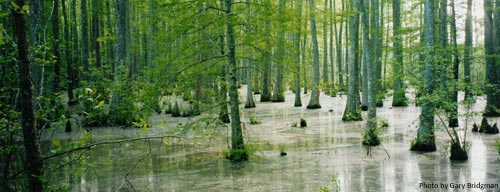A bottomland hardwood forest is basically a “swamp” or deciduous forested wetland. These lowland forests grow along river “bottoms,” and tend to flood during the rainy season. The Mississippi Valley was entirely covered by bottomland hardwood forest at the time of European settlement, when it was the largest extent of that habitat type on earth. For about one hundred years, beginning with the first Swamp Land Act in 1849, the federal government provided incentives to states and landowners to reclaim, or drain, bottomland forests for agriculture or development.
 A bottomland hardwood forest is basically a “swamp” or deciduous forested wetland. These lowland forests grow along river “bottoms,” and tend to flood during the rainy season.
A bottomland hardwood forest is basically a “swamp” or deciduous forested wetland. These lowland forests grow along river “bottoms,” and tend to flood during the rainy season.
The Mississippi Valley was entirely covered by bottomland hardwood forest at the time of European settlement, when it was the largest extent of that habitat type on earth. For about one hundred years, beginning with the first Swamp Land Act in 1849, the federal government provided incentives to states and landowners to reclaim, or drain, bottomland forests for agriculture or development.
Since then, over 80% of the bottomlands have been cleared, and the hydrology has been drastically altered. Much of the remaining forest exists in small fragments. An excellent set of maps clearly showing these effects in the lower Mississippi Valley can be seen at Southern Forests for the Future. The area is mostly in private ownership, and much private forest land is owned by the forest products industry or limited partnership hunting clubs and is thus likely to remain forested.
Restoration opportunities
Well-drained land is valuable for agriculture and most current lands with forest remaining as well as the marginal agricultural sites are poorly-drained. Since the 1980s, forest clearing has essentially stopped, and federal “Farm Bill” programs, especially the Conservation Reserve Program and the Wetland Reserve Program, have provided incentives for restoration of agricultural land.
In addition to public restoration programs, private interests are proving essential in increasing forest restoration opportunities and management alternatives for landowners. Landowner assistance programs offered by forest industry in the lower Mississippi Valley often provide technical assistance and provide landowners an opportunity to draw revenue from investments in forest plantation establishment.
Private interest in forest restoration promises to increase as a market for carbon sequestration develops in the U.S. Several utility cooperatives and private companies, speculating that a market for carbon offsets will soon develop, have already invested in afforestation or forest creation.
Ecology
Though they have been radically altered, the oak-hickory-pine forests of the Mississippi lowlands still support millions of migrating waterfowl and songbirds within the Mississippi Flyway.
Bottomland hardwood forests can be categorized into four types based on flood regime:
- river swamp forest is classic “swampland” where bald cypress and water tupelo sprout from thick trunks periodically submerged in standing water.
- lower hardwood swamp forest is more diverse, with water hickory, red maple, and green ash along with understory plants such as jewelweed and royal fern
- backwater and flats forest include lower hardwood species along with sweet gum, sycamore, laurel oak, and willow oak, often draped in woody vines such as poison ivy, greenbrier, and trumpet creeper
- upland transitional forest occur along ridges and higher ground, supporting oak-hickory-pine communities.
 Sign In
Sign In
 Sign In
Sign In
